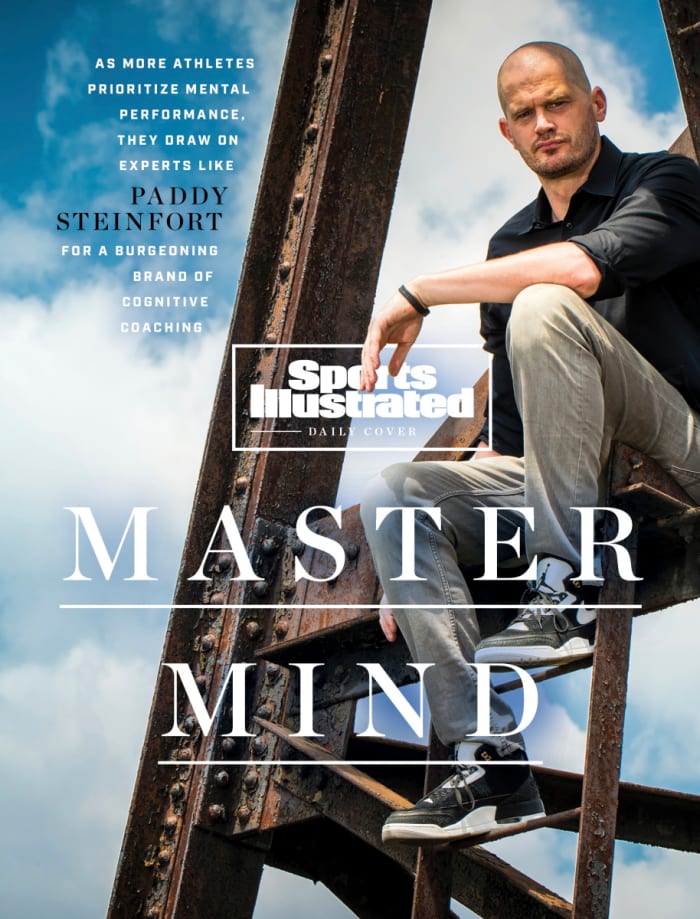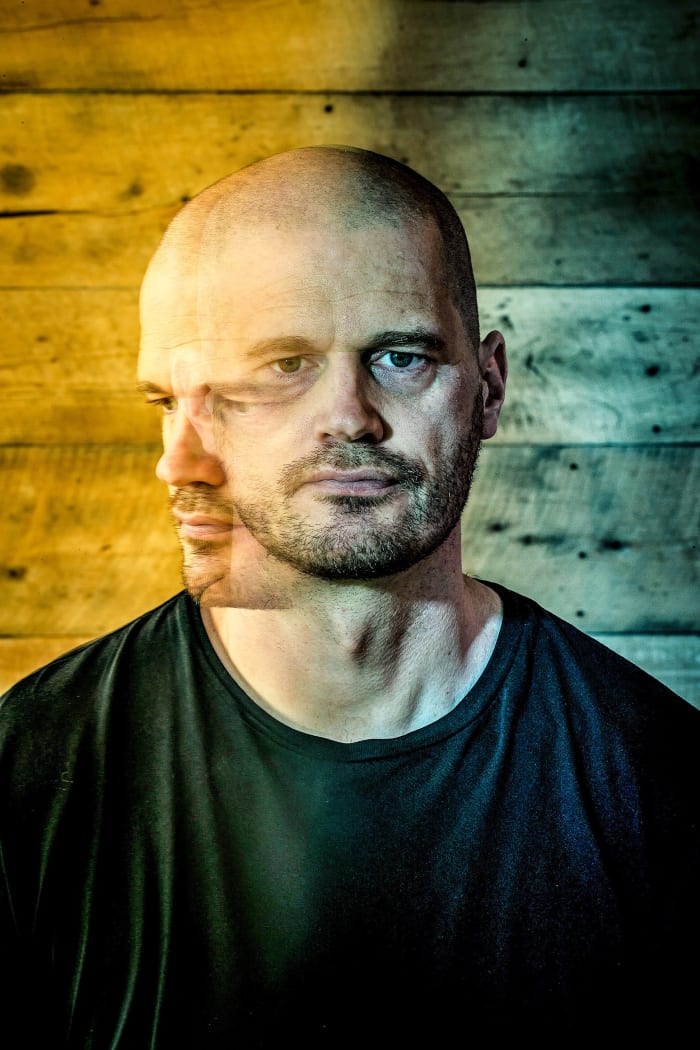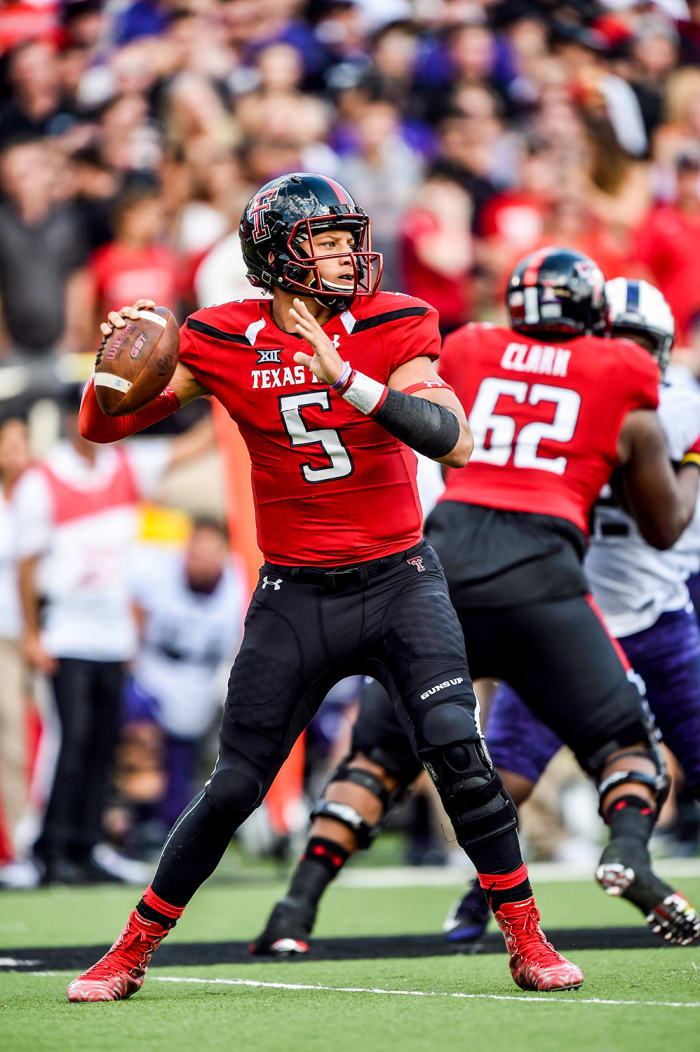“Don’t f--- this up,” Paddy Steinfort tells a major league pitcher throwing his bullpen session. “Don’t f--- this up. Don’t f--- it up.”
Standing directly behind the right-hander as he heaves pitch after pitch, Steinfort fine-tunes his provocations: “Don’t hang the curveball. Don’t hang it out there. I haven’t got this pitch today. Is the coach coming out for a mound visit? Or is the GM in the stands looking at me right now?”
Steinfort is giving voice to the stream of distracting thoughts rattling around the pitcher’s head so that he can recognize and overcome them. The 41-year- old former Australian Rules football player and physiotherapist turned mental performance coach likens this approach to nudging a ballplayer who’s rehabbing a knee injury off-balance as he tries to throw and catch a ball. “I’ll try and push your attention forward, I’ll try and shift it to the dugout or to the stands,” Steinfort says, “and your job as a performer is to bring it back to where I am right now.”
A native of Melbourne, Steinfort has worked with teams in the NFL (Eagles), MLB (Blue Jays, Red Sox) and NBA (76ers), as well as with athletes in seven other sports, and with the U.S. Army. He has helped players develop from relative obscurity into Olympic champions, league MVPs and No. 1 draft picks. That list includes Sixers All-Stars Ben Simmons, Toronto phenom Vladimir Guerrero Jr. and Chiefs quarterback Patrick Mahomes, now the NFL’s highest-paid player, when he was at Texas Tech.
Like many mental performance coaches, Steinfort is not a licensed psychologist or psychiatrist, though he is trained to spot signs of mental illness and make referrals to other professionals. He focuses on developing cognitive skills, such as confidence, focus and motivation, just as a strength and conditioning coach helps enhance an athlete’s power, speed and agility. The practice isn’t new, but in the last decade, more and more college and pro teams are embracing practitioners of this burgeoning field.
In the NBA, for example, the Mavs hired the league’s first full-time mental skills coach around the turn of the century. Today, about half the teams have one on staff. (And the NBA now requires every team to have a full-time mental health professional, either a licensed psychologist or behavioral therapist.) In addition to director of mental skills Don Kalkstein in Dallas, these coaches in various leagues go by various titles, such as Tampa Bay Rays mental performance coach Justin Su’a, Green Bay Packers director of performance psychology Chris Carr and New Jersey Devils director of player and team development Aimee Kimball.
Despite evidence showing the benefits of mental skills training for athletes, coaches and owners aren’t exactly known for embracing innovation. (See: the slow adoption of sabermetrics.) Also, it can be hard to find a qualified person who can work seamlessly with physical therapists, doctors and the rest of the staff. And for any of it to be effective, players and coaches must first buy in. “Many coaches will just roll their eyes at the mention of psychological flexibility or mindfulness,” says Steven C. Hayes, a professor of psychology at Nevada.
It helps that top athletes are dialing up the conversation around mental health and wellness: Michael Phelps, Simone Biles, Kevin Love and many others have spoken about the value of therapy in overcoming depression and anxiety. And for overall well-being, stars like LeBron James, Carli Lloyd and Steph Curry have added meditation and visualization exercises into their pre-competition routines.
Steinfort uses a range of techniques to help players keep their minds clear and focused on performing, even when they’re not feeling their best. That means working not only with the athlete but also learning their moods and needs from teammates, friends and family. “I joke about it being like a secret agent,” Steinfort says. “Because it’s often background work and just a matter of subtly hearing things to figure out what’s really going on for a person.”
***
In early March, point guard T.J. McConnell was headed to Philadelphia with a 2015 vintage bottle of Penfolds Grange, an Australian wine, in hand. Before the coronavirus shut down the NBA season on March 11, his Pacers were set to face the Sixers, which meant McConnell, 28, who played in Philly for four years, would be reunited with Steinfort. “With that comfort level I have with him, he was able to break me out of my shell,” says McConnell. “I’m never one to really sit down and talk with someone about how I played or a bad stretch, but he’s the guy where he’s like, We don’t have to meet in my office. Let’s go get a bite to eat and make it super casual and just talk.”
McConnell, who admits he’s “high-strung,” recalls an informal, courtside conversation he had with Steinfort at the AT&T Center in San Antonio, when he was stressing out before a game. Steinfort’s advice was simple, and seemingly inane: Just read the signs. So a nervous, skeptical McConnell spotted each banner hanging from the rafters and read the text, calming down all the while.
“It kind of got me into this Zen,” he says. “It was weird.” Sign-reading soon became part of the pregame routine for McConnell, who last season signed a two-year, $7 million deal with Indiana.
McConnell initially trusted Steinfort in part because he was an athlete himself: an Aussie Rules first-round selection of the Richmond Tigers at age 17. The 6' 6", 230-pound ruckman bounced around the sport for almost a decade, battling broken hands and feet, concussions, muscle strains and more. In the early 2000s, in one of Steinfort’s first interactions with the profession he would later join, a Tigers performance coach encouraged him to give it his all despite his injuries, imparting a valuable lesson he shares with his clients today: The game doesn’t give a s--- how you feel.
“If you turn up and you don’t feel good, the scoreboard’s still going to register what you do, not what you feel,” Steinfort says. “The opponent doesn’t care how you feel. The referee doesn’t care how you feel. The fans who are paying money for it sure as s--- don’t care how you feel.”
After retiring at 26, Steinfort eventually took his first job as a coach in 2011, with the Adelaide Crows. He never intended to build a career focused on mental performance, but that’s what the team needed when they presented him with the following challenge: What can we look for in a prospect’s psychological profile to help us unearth hidden gems?
Steinfort focused on qualities like grit and optimism to find athletes who compete despite setbacks, stay true to their goals, work humbly and push through tough physical challenges when they’re not in the mood. He began compiling player profiles ahead of draft night, gathering insight from surveys prospects were given at draft camps, and took self-paid trips to the U.S. to learn best practices in the mental coaching field from different leagues.
After Adelaide made a coaching change, Steinfort took a buyout, moved to the States in ’14 and earned his master’s in applied psychology at Penn a year later. Steinfort got his big break from Eagles coach Chip Kelly, who hired him as a performance coach in ’15 to teach rookies resilience education. That led to gigs with the Blue Jays and Texas Tech in Steinfort’s expanding portfolio of sports, which now includes athletes from Aussie Rules, cricket, rugby, soccer, golf, swimming and esports.
Each sport, he says, has its quirks, but Steinfort offers all the same menu of services: leadership coaching for athletes who want to set team standards and shape behaviors; relationship management for those who want to improve connections; mindfulness practice, which teaches focus and presence, especially under stress; expression sessions, in which the athlete shares emotional experiences to help quell unhelpful thoughts; and more.
Ultimately, Steinfort doesn’t view his job as “calming the seas” to make athletes’ rides less choppy—it’s to enable them to hold themselves steady when the skies turn stormy.
***
Since the coronavirus pandemic, Steinfort’s role has taken on increased importance—and busyness. He must help players deal with what he calls the four “uns”: an uncertain situation, an unclear future, unknown parameters and unexpected, novel stressors. At the same time, after the police killings of George Floyd, Breonna Taylor and other Black people nationwide, the Black Lives Matter movement has gained momentum. Steinfort’s job isn’t to counsel athletes dealing with grief or other clinical issues, but he does “help them hold space for it” while competing so they can perform their best while sifting through challenging issues outside the game. “It can be difficult to go from so much momentum on the social justice front to possibly unmet (or under-met) expectations, as well as a shift in focus,” he writes in an email. “And if we don’t attend to that, individuals can develop feelings of loss or lack of mattering.”
Steinfort has a disarming charm that helps him relate to athletes who come from diverse backgrounds. “He’s got the accent. He’s from a part of the world that they’ve never been to, probably, and played a different sport,” says Arizona Cardinals coach Kliff Kingsbury, who worked with Steinfort at Texas Tech. “But he had a way of putting those guys at ease. Anytime he showed up, their eyes lit up.”
Mental coaching is not all charm and character, though. It gets results on a neurological level, according to Hayes. He says athletes who are more “psychologically flexible”—a personality trait that describes an individual’s ability to stay in the present moment, regardless of unpleasant thoughts or emotions, and behave according to one’s values— are more likely to succeed. For example, in a 2018 study of elite-level hockey players in Sweden, a high flexibility, or mindfulness, score—measured by an adaptation of a common psychological questionnaire—correlated to an increase in players’ assists and a team’s points.
Hayes also references the Stroop test, a neuropsychological experiment used to measure attention capacity, processing speed and ability to prevent cognitive interference. In it, the word blue, for example, is written on screen in the color green, and the participant is asked to read the color of the word, not what the word says. Athletes who are able to focus blurt out the right color quickly. They do the same thing on the court: Mindfulness allows players to easily adapt to situational changes and “broaden” by processing what’s happening even at the peripheries of their vision, so they can predict where their teammate’s going to be for a key pass. “It requires practice,” Hayes says. “This is not woo-woo. You can show it at the physiological . . . level.”
Each month as Steinfort parachuted into Lubbock, Texas, to spend a few days with the Red Raiders, one player caught his eye in routine small-group and one-on-one sessions with team leaders: Mahomes. “He would be open and honest about what was on his mind,” Steinfort recalls. “He was a focused, hard-working, competitive beast who was humble and hungry to do whatever it took to get better.”
Competitiveness is key: That’s one of five traits Steinfort says can accurately predict performance, much better than, say, how confident an athlete is. (As for the other four, he says he’s not giving away his “secret sauce.”) By that logic, it’s no surprise that despite being just a three-star recruit out of high school, Mahomes went 10th in the 2017 NFL draft to Kansas City and has already been a league and Super Bowl MVP.
“Pat felt like he could trust him, and Paddy never tried to be over the top, but wanted to be a resource to him,” Kingsbury says. “Just wanted to be a sounding board.”
It’s not always easy for athletes to confide in a professional like Steinfort. Due to expectations of “mental toughness” and, for the men he works with, stereotypes about masculinity, it can difficult for them to channel their emotions, let alone share their vulnerabilities—especially with someone who works for their team and could adversely affect their livelihood. For this reason, Steinfort says he keeps details of each player’s trials and tribulations confidential from team officials. “You were probably the only person that I really opened up to,” 49ers running back Raheem Mostert recently told Steinfort on the latter’s Toughness Podcast.
Hayes notes how important character is for coaches like Steinfort, whom he credits with building MLB’s best mental skills program with the Blue Jays. “If you ever lie, if you ever manipulate, you’re done,” Hayes says. “The [successful] coaches tend to have that quality of being engaging and fun and creative— in the moment, not formulaic—so you can come at players from different angles that fit them.”
Rockies outfielder Kevin Pillar, who first worked with Steinfort in Toronto, relayed athletes’ fears of opening up to his old performance coach: “There’s a stigma around people in your line of work—especially in baseball,” Pillar said on Steinfort’s podcast. “Personal information is so important because we feel like everything is used against us. There’s always some reason not to sign or play us, right?”
Pillar sought out Steinfort because he wanted to use every opportunity available to improve. Along with breathing exercises, he began practicing mindfulness by focusing on his back foot every time he entered the batter’s box, noticing the way his spikes dug into the dirt. “It was this metaphor of being present in the moment,” Pillar says.
Conner Greene, a 25-year-old right-handed pitcher now with the Royals, took to Steinfort when in the Blue Jays’ farm system. The two would also work on focus, sitting together after each game to see whether one box could be checked: Did Greene, then 19 or 20, focus on every single pitch he threw that day, without letting his mind wander off the mound? For a while, the answer was always no, but slowly but surely, he improved. “My focus was normal, and he turned me into laser Navy SEAL focus,” he says. The two also worked to set a routine for Greene, which helped him start to treat baseball as a true profession and less as just a game. “He was a very relatable, intelligent, freaking mental beast,” Greene says.
But not every athlete is eagerly soliciting Steinfort’s services. Norvel Pelle, a Sixers rookie center and G League journeyman who was thinking too much before stepping on the court, finally decided to work with Steinfort a year after being introduced to him. The two have meditated together often, lessening Pelle’s overwhelming emotions. It was an unusual step for the 27-year-old, who says, “I’m the type of person who doesn’t talk about my feelings. . . . He’s a lifesaver.”
Steinfort is a master of helping athletes focus on what demands their attention while helping them file away other thoughts—one of the main attributes of psychological flexibility. “At the wrong time and with the wrong focus, looking at their emotions can actually be harmful, and so they learn to avoid it,” Steinfort says, “rather than be flexible about when and how they do it.”
***
Mental performance principles don’t just apply to traditional sports. The Sixers own Dignitas, an esports organization, and Steinfort works with its all-female Counter-Strike: Global Offensive team, which has won back-to-back Intel Extreme Masters Katowice championships in Poland. Even though competitors are sitting at computers, not sprinting through an arena, the cerebral component is perhaps even more important for their success.
“It produces the same threat response internally, in terms of our sympathetic nervous system kicking in, heart rate going up and breathing getting more shallow,” Steinfort says. “It happens the same as it would when stepping up to shoot some clutch free throws.”
Esports competitors like the members of Dignitas face cognitive hurdles that don’t slow many traditional athletes, who often execute physical tasks without even thinking. “In football as a wide receiver, even if my mind is somewhere else, I’m so well trained physically that I can still execute the move,” Steinfort says. “While I’m playing esports, yeah, my thumbs will still work, but it’s very important for me to be super aware of what my teammates and opponents are doing, to be able to spot a target....In a way, it’s actually more challenging when their system gets hijacked by the stress response.”
Emmalee (Emuhleet) Garrido, the captain of Dignitas’s five-member CS:GO team, tries to spend as much time with Steinfort as possible whenever the team visits the Sixers’ facilities. With his guidance, Garrido visualizes what could go wrong in a match, along with how to adapt to it, and braces for the worst: Computers crash, the mice sit on uneven tables, opponents bury them. It happens. It’s the same strategy Phelps used when he famously won the 200-meter butterfly at the Beijing Olympics even though his goggles had filled with water—a stressful situation he had visualized in practice. (Hayes notes that the practice of visualization can backfire if an opponent reacts in a way that the athlete had not envisioned.)
“[Steinfort] doesn’t treat us any differently because we’re gamers or because we’re girls,” Garrido says. “He treats us the same as he treats the basketball players. He tells us what we need to hear, not what we want to hear.”
Pelle has started sharing his breathing and meditation exercises with friends and family. That’s exactly the kind of spread that excites Steinfort—it shows his teachings are making an impact beyond the sports community. And, aside from the fact that the game doesn’t give a s--- how you feel, what is it that athletes have learned?
“You can’t stop the waves in life,” Steinfort says, “but you can learn how to surf.”








